What is a Capstone Project Rubric, and How is it Used?
The capstone project rubric is a comprehensive evaluation tool for assessing your capstone project’s quality. It clearly explains the criteria for evaluating your work and is essential for ensuring a fair and objective assessment. The capstone project rubric is divided into several components, each evaluated based on specific criteria. A capstone project rubric typically includes presentation, originality and creativity, technical skills, and communication and collaboration. The criteria used to evaluate each component are weighted based on their importance to the project, and the weighted average of all components determines the overall score. Also, the guide on the capstone project will help to get things clear.

Components of the Capstone Project Rubric: A Breakdown
Let me break it into parts for your ease.
Presentation: Assessing the Visual and Organizational Aspects
The presentation component of the capstone project rubric is designed to evaluate your ability to articulate your ideas clearly and professionally. The evaluators will seek evidence of effective visual aids, clear and concise communication, and overall professionalism. This component is important because it reflects your ability to present your ideas in a manner that is accessible and engaging to your audience. To perform well in this component, you must articulate your ideas clearly and concisely and use visual aids to enhance your presentation.
Originality and Creativity: Recognizing Innovative Ideas and Approaches
The originality and creativity component of the capstone project rubric is designed to assess your ability to generate innovative solutions to problems and approach tasks creatively. The evaluators will look for evidence of original ideas, innovative solutions, and creative problem-solving. This component is important because it reflects your ability to think critically and independently and develop practical and effective solutions. To perform well in this component, you must demonstrate a strong understanding of the principles of originality and creativity and apply them practically and effectively. Also, you may find topic ideas for your capstone project .
Technical Skills: Evaluating the Use of Tools and Techniques
The technical skills component of the capstone project rubric is designed to assess your ability to apply the knowledge and skills you have learned throughout your academic journey. This component evaluates your ability to use software, hardware, and other technical tools to solve problems and complete tasks. The evaluators will also examine your problem-solving skills and ability to work independently. To perform well in this component, you must demonstrate a strong understanding of the technical skills required for the project and apply them practically and effectively. This component is important because it reflects your ability to apply your technical knowledge and skills practically and meaningfully. Of course, other tips on a capstone project will help with writing.
Communication and Collaboration: Measuring Teamwork and Interpersonal Skills
The final component of the capstone project rubric is communication and collaboration. This component evaluates your ability to work effectively with others and communicate your ideas and solutions. The evaluators will look at your ability to collaborate with your team members, participate in group discussions, and present your ideas clearly and concisely. You can find additional information on criteria on a capstone project and other useful tips on different forums. Effective communication and collaboration are essential for success in a capstone project. Therefore, paying close attention to this component is important to ensure you receive a fair evaluation. To perform well in this component, you must communicate your ideas effectively, participate in group discussions, and work effectively with others to achieve common goals and how not fail your capstone project .
Here is an interesting video to watch:
Why the Capstone Project Rubric is Important for Students and Evaluators
The capstone project rubric is important for several reasons:
- ☑️ It clearly explains the criteria used to evaluate your work. This helps to ensure that you receive a fair and objective assessment and that you can understand what is expected of you.
- ☑️ The capstone project rubric provides a roadmap for your project, which can help you stay on track and ensure that you can meet all of the project’s requirements.
- ☑️ The capstone project rubric helps you understand what is required of you and what you must do to receive a good grade.
Furthermore, the capstone project rubric also helps you identify areas of improvement. The rubric can highlight your strengths and weaknesses by categorizing the evaluation criteria into specific components and types . This can help you identify areas where you need to focus your efforts and improve your skills.
For evaluators, the capstone project rubric provides a standardized way to assess the quality of student work. It ensures that all students are evaluated based on the same criteria, which helps to promote fairness and consistency. Additionally, the rubric helps evaluators provide constructive feedback to students. By breaking down the evaluation criteria into specific components, evaluators can provide targeted feedback on what students did well and where they need to improve.
Finally, the capstone project rubric can help students and evaluators identify areas where additional support or resources may be needed. For example, suppose many students struggle with a specific aspect of the project, such as communication or technical skills, and a lack of time for writing a capstone project . In that case, this may indicate a need for additional instruction or resources in those areas.
In short, the capstone project rubric is essential for both students and evaluators. It provides a clear understanding of the evaluation criteria, helps students stay on track with their projects, identifies areas for improvement, and ensures that all students are evaluated fairly and consistently.
➡️ get help with your capstone project ⬅️
Tips for Writing a Successful Capstone Project Paper: Best Practices and Strategies
Now that you understand the capstone project rubric well, it is important to turn your attention to the actual writing of your capstone project paper. Also, important to know the guidelines for writing the capstone project . Here are some tips for writing a capstone project paper that will help you to receive a fair and objective evaluation:
- ☑️ Use Active Voice: When writing your capstone project paper, it is important to use active rather than passive voice. This makes your writing more engaging and easier to understand.
- ☑️ Avoid Consecutive Sentences Starting with the Same Word: Consecutive sentences starting with the same word can make your writing monotonous and boring. To avoid this, try to mix things up and start sentences with different words.
- ☑️ Use Transition Words: Only 35% of your sentences should contain transition words. This helps to make your writing more fluid and easier to follow.
- ☑️ Maintain Paragraph Length: It is important to ensure that your paragraphs are not too long. Long paragraphs can make your writing difficult to follow and make it difficult for evaluators to understand your ideas.
- ☑️ Keep Sentences Short: Sentences that are too long can make your writing difficult to follow and can be difficult for evaluators to understand. It is important to keep sentences short and concise to ensure your writing is easy to follow.

A capstone project rubric is an essential tool for evaluating the quality of your capstone project. It provides a clear understanding of the criteria for assessing your work and is critical for ensuring a fair and objective assessment. You can use the help of our professional writing team at Writing Metier to get a perfect capstone project.
By understanding the capstone project rubric and following the tips for writing a capstone project paper, you can increase your chances of receiving a good grade and completing your capstone project.
Free topic suggestions
Laura Orta is an avid author on Writing Metier's blog. Before embarking on her writing career, she practiced media law in one of the local media. Aside from writing, she works as a private tutor to help students with their academic needs. Laura and her husband share their home near the ocean in northern Portugal with two extraordinary boys and a lifetime collection of books.
Similar posts
The capstone project is a culmination of a student's academic journey and is designed to showcase their skills and knowledge. A crucial aspect of the capstone project is the assessment and grading process, which is done using a capstone project rubric. The rubric outlines the marking criteria used to evaluate the student's work and is a valuable resource for both students and instructors. In this article, we will delve into the key elements of the capstone project rubric and provide tips on how to excel in your capstone project and achieve top marks. Understanding the capstone project rubric and its evaluation criteria will help you produce a high-quality project and demonstrate your mastery of the subject matter.
Capstone Project Topic Ideas: 100+ Examples in Different Fields
More than 100 different capstone project topics are listed by the areas of study. You just need to choose the idea that suits you best. I wish you a good read ;)
Business Capstone Project Ideas
Business Capstone Project Ideas - a list of Business Capstone Project Ideas, carefully crafted to guide students in creating thought-provoking essays that showcase their expertise and understanding of real-world business challenges.
Community Capstone Project Ideas
Capstone projects are a critical component of many academic programs, allowing students to apply their skills and knowledge to real-world issues. Community-based capstone projects, in particular, allow students to make a positive impact on their local communities and develop valuable skills in project management, research, and communication.
How Long Does It Take to Do a Capstone Project? ⏳
A capstone project is a complex academic project that is completed by students in their final year of study. The duration of a capstone project can vary depending on several factors such as the subject area, the scope of the project, and the individual student's pace of work.
How to Write a Capstone Project Proposal? ✍
Are you about to embark on a capstone project and wondering how to write a winning proposal? Look no further! In this guide, we will break down the key elements of a successful capstone project proposal, so you can present a compelling case for your project.
Is It Legal to Order a Capstone Project Online?
Is It Legal to Order a Capstone Project Online? - If you're a student working on a capstone project, you may have considered ordering it online. There are numerous websites and services that offer custom capstone projects for sale, and it can be tempting to take advantage of these offers. However, before you place your order, it's important to understand the potential risks and legal issues associated with buying academic work online.
Marketing Capstone Project Ideas
Providing you with a list of marketing capstone project ideas covering a range of marketing areas, including digital marketing, traditional marketing, guerrilla marketing, public relations, sustainable and ethical marketing, and emerging marketing trends and technologies.
Nursing Capstone Project Ideas
Nursing Capstone Project Ideas - From researching specific medical conditions to exploring the impact of technology on nursing practice, our ideas cover a wide range of topics. We understand the importance of selecting a compelling and relevant topic that aligns with your interests and career goals.
We rely on cookies to give you the best experince on our website. By browsing, you agree to it. Read more
Eberly Center
Teaching excellence & educational innovation, grading and performance rubrics, what are rubrics.
A rubric is a scoring tool that explicitly represents the performance expectations for an assignment or piece of work. A rubric divides the assigned work into component parts and provides clear descriptions of the characteristics of the work associated with each component, at varying levels of mastery. Rubrics can be used for a wide array of assignments: papers, projects, oral presentations, artistic performances, group projects, etc. Rubrics can be used as scoring or grading guides, to provide formative feedback to support and guide ongoing learning efforts, or both.
Advantages of Using Rubrics
Using a rubric provides several advantages to both instructors and students. Grading according to an explicit and descriptive set of criteria that is designed to reflect the weighted importance of the objectives of the assignment helps ensure that the instructor’s grading standards don’t change over time. Grading consistency is difficult to maintain over time because of fatigue, shifting standards based on prior experience, or intrusion of other criteria. Furthermore, rubrics can reduce the time spent grading by reducing uncertainty and by allowing instructors to refer to the rubric description associated with a score rather than having to write long comments. Finally, grading rubrics are invaluable in large courses that have multiple graders (other instructors, teaching assistants, etc.) because they can help ensure consistency across graders and reduce the systematic bias that can be introduced between graders.
Used more formatively, rubrics can help instructors get a clearer picture of the strengths and weaknesses of their class. By recording the component scores and tallying up the number of students scoring below an acceptable level on each component, instructors can identify those skills or concepts that need more instructional time and student effort.
Grading rubrics are also valuable to students. A rubric can help instructors communicate to students the specific requirements and acceptable performance standards of an assignment. When rubrics are given to students with the assignment description, they can help students monitor and assess their progress as they work toward clearly indicated goals. When assignments are scored and returned with the rubric, students can more easily recognize the strengths and weaknesses of their work and direct their efforts accordingly.
Examples of Rubrics
Here are links to a diverse set of rubrics designed by Carnegie Mellon faculty and faculty at other institutions. Although your particular field of study and type of assessment activity may not be represented currently, viewing a rubric that is designed for a similar activity may provide you with ideas on how to divide your task into components and how to describe the varying levels of mastery.
Paper Assignments
- Example 1: Philosophy Paper This rubric was designed for student papers in a range of philosophy courses, CMU.
- Example 2: Psychology Assignment Short, concept application homework assignment in cognitive psychology, CMU.
- Example 3: Anthropology Writing Assignments This rubric was designed for a series of short writing assignments in anthropology, CMU.
- Example 4: History Research Paper . This rubric was designed for essays and research papers in history, CMU.
- Example 1: Capstone Project in Design This rubric describes the components and standard of performance from the research phase to the final presentation for a senior capstone project in the School of Design, CMU.
- Example 2: Engineering Design Project This rubric describes performance standards on three aspects of a team project: Research and Design, Communication, and Team Work.
Oral Presentations
- Example 1: Oral Exam This rubric describes a set of components and standards for assessing performance on an oral exam in an upper-division history course, CMU.
- Example 2: Oral Communication
- Example 3: Group Presentations This rubric describes a set of components and standards for assessing group presentations in a history course, CMU.
Class Participation/Contributions
- Example 1: Discussion Class This rubric assesses the quality of student contributions to class discussions. This is appropriate for an undergraduate-level course, CMU.
- Example 2: Advanced Seminar This rubric is designed for assessing discussion performance in an advanced undergraduate or graduate seminar.

Science and Information Conference
SAI 2018: Intelligent Computing pp 219–233 Cite as

Quality Scale for Rubric Based Evaluation in Capstone Project of Computer Science
- Zeeshan Haider Malik 17 ,
- Sabur Butt 17 &
- Hanzla Sajid 17
- Conference paper
- First Online: 02 November 2018
1780 Accesses
Part of the book series: Advances in Intelligent Systems and Computing ((AISC,volume 857))
Capstone projects in computer science are in the scrutiny of wide range of subjectivity because students are mostly unaware about the details of the evaluation process. The authors have attempted to mitigate subjectivity by classifying the types of capstone projects and introducing new evaluation model to evaluate them. Paper provides a rubric for each identified category for assigning a grade with a standard scale. The views have been sought out from professors of seven international universities. The results are reported and critically analyzed on each factor that is presented in the paper.
- Capstone project
- Computer science education
- Rubric based evaluation
This is a preview of subscription content, log in via an institution .
Buying options
- Available as PDF
- Read on any device
- Instant download
- Own it forever
- Available as EPUB and PDF
- Compact, lightweight edition
- Dispatched in 3 to 5 business days
- Free shipping worldwide - see info
Tax calculation will be finalised at checkout
Purchases are for personal use only
Jawitz, J., Suellen, S., Moore, R.: Management and assessment of final year projects in engineering. Int. J. Eng. Educ. 18 (4), 472–478 (2002)
Google Scholar
Barney, S., et al.: Improving students with rubric-based self-assessment and oral feedback. IEEE Trans. Educ. 55 , 319–325 (2012)
Article Google Scholar
Sharef, N., Hamdan, H., Madzin, H.: Innovation-enhanced rubrics assessment for final year projects. Glob. J. Eng. Educ. 16 (3), 129–135 (2013)
Jonsson, A., Svingby, G.: The use of scoring rubrics: reliability, validity and educational consequences. Educ. Res. Rev. 2 (2), 130–144 (2007)
Dickerson, S., Jacobs, S., Garcia, A., Sanchez, D.: Joint assessment and evaluation of senior design projects by faculty and industry. In: Frontiers in Education Conference (2016)
Allison, J., Benson, F.A.: Undergraduate projects and their assessment. IEE Proc. A Phys. Sci. Measur. Instrum. Manag. Educ. Rev. 130 (8), 402–419 (1983)
Sharef, N.M., et al.: Rubric-based evaluation for final year project in computer science. In: International Conference on Engineering in Education (2013)
Beyerlein, S., et al.: Assessment framework for capstone design courses. In: Proceedings of the American Society for Engineering Education Annual Conference and Exposition (2006)
Erradi, A.: easyCapstone: a framework for managing and assessing capstone design projects. In: 2012 7th International Conference on Computer Science and Education (ICCSE), pp. 1345–1350. IEEE (2012)
Yousafzai, J., Damaj, I., ElAbd, M.: A unified approach for assessing capstone design projects and student outcomes in computer engineering programs. In: 2015 IEEE Global Engineering Education Conference (EDUCON), pp. 333–339. IEEE (2015)
Download references
Author information
Authors and affiliations.
Computer Science Department, Forman Christian College (A Chartered University), Lahore, Pakistan
Zeeshan Haider Malik, Sabur Butt & Hanzla Sajid
You can also search for this author in PubMed Google Scholar
Corresponding author
Correspondence to Zeeshan Haider Malik .
Editor information
Editors and affiliations.
Faculty of Science and Engineering, Department of Information Science, Saga University, Honjo, Saga, Japan
The Science and Information (SAI) Organization, Bradford, West Yorkshire, UK
Supriya Kapoor
Rahul Bhatia
Rights and permissions
Reprints and permissions
Copyright information
© 2019 Springer Nature Switzerland AG
About this paper
Cite this paper.
Malik, Z.H., Butt, S., Sajid, H. (2019). Quality Scale for Rubric Based Evaluation in Capstone Project of Computer Science. In: Arai, K., Kapoor, S., Bhatia, R. (eds) Intelligent Computing. SAI 2018. Advances in Intelligent Systems and Computing, vol 857. Springer, Cham. https://doi.org/10.1007/978-3-030-01177-2_16
Download citation
DOI : https://doi.org/10.1007/978-3-030-01177-2_16
Published : 02 November 2018
Publisher Name : Springer, Cham
Print ISBN : 978-3-030-01176-5
Online ISBN : 978-3-030-01177-2
eBook Packages : Intelligent Technologies and Robotics Intelligent Technologies and Robotics (R0)
Share this paper
Anyone you share the following link with will be able to read this content:
Sorry, a shareable link is not currently available for this article.
Provided by the Springer Nature SharedIt content-sharing initiative
- Publish with us
Policies and ethics
- Find a journal
- Track your research
Academia.edu no longer supports Internet Explorer.
To browse Academia.edu and the wider internet faster and more securely, please take a few seconds to upgrade your browser .
Enter the email address you signed up with and we'll email you a reset link.
- We're Hiring!
- Help Center

Using Rubrics in a Capstone Engineering Design Course

Rubrics have been developed to assess the proposal, interim report, final report and proposal as related to the engineering capstone project, to better assess the performance of the students and provide feedback to the students. The presentation will outline how the rubrics were developed and highlight some the challenges that arose in implementing them. In addition, the rubrics were structured to address the majority of graduate attributes outlined by the Canadian Engineering Accreditation Board (CEAB). As such the rubrics assess student performance in the following graduate attributes: design, problem analysis, investigation, communication skills, impact of engineering on society and environment, and economics and project management. Through the learning management system used at the SOE, the rubric data can also be collected and reviewed as part of the graduate attribute process that has become an important component of the CEAB accreditation process. Challenges in using the lear...
Related Papers
Proceedings of the Canadian Engineering Education Association
Oscar Nespoli
Capstone projects offer an excellent oppor- tunity to assess the attributes of engineering students in their final year of studies. For the purposes of accredi- tation and outcomes assessment, capstone projects can be used to establish that engineering students have ob- tained a suitable level of mastery of the skills necessary to be successful in their field of study. At the University of Waterloo, a committee was formed by the Faculty of Engineering to investigate, develop, and implement a common set of rubrics for the purpose of consistently assessing graduate attributes across all engineering disciplines. Faculty members from every engineering discipline were appointed to the committee. Using the collective experience of the committee members, a set of rubrics for outcomes assessment was established. This paper examines the design of the six rubrics that the committee deemed to be equally applicable to all engineering disciplines. These rubrics assess the CEAB graduate attribute...
Steven Beyerlein
Capstone engineering design courses occupy pivotal positions in every engineering baccalaureate degree program. They are critical to preparing graduates with professional skills needed for innovative, responsible practice in a global environment, and they provide vital assessment data for ABET accreditation of degree programs. This paper describes assessment instruments developed for capstone engineering design courses, filling a crucial gap facing design educators. Seven assessment exercises are presented to address three areas of performance for capstone engineering design. Each exercise is accompanied by a scoring rubric structured around performance factors and five levels of performance. Suggestions given for utilization for formative and summative purposes make these assessments valuable for guiding student learning and assigning performance scores or grades. These assessments constitute foundational parts of an assessment system for capstone engineering design courses. Introd...
2007 Annual Conference & Exposition Proceedings
Patricia Brackin
2006 Annual Conference & Exposition Proceedings
Nariman Sepehri
This paper discusses the evolution of a set ofrubrics for the 12 CEAB graduate attributes in theFaculty of Engineering at the University of Manitoba. Therubrics are intended as a pedagogical assessment tool forinstructors of individual courses as applicable, and forassessment at the program level. Individuals from faculty,industry and the University of Manitoba Centre for theAdvancement of Teaching and Learning have beeninvolved in the process of evaluating and revising boththe content and wording of the rubrics in order that theymeet the following criteria: (i) the foci and indicatorsadequately communicate the knowledge, skills, attitudes,values and behaviours that our engineering stakeholdersagree do define each attribute; (ii) the competency levelfor each indicator is representative of what engineeringeducators and stakeholders agree defines proficiency;and (iii) the language in the rubrics is consistent andagreeable to all engineering stakeholders. These rubricsare expected to a...
Beyerlein is professor of Mechanical Engineering at the University of Idaho, where he coordinates the Mechanical Engineering and Electrical Engineering capstone design program and where he regularly participates in ongoing program assessment activities. For these efforts he won the UI Outstanding Teaching Award in 2001. He has been an active participant in the Transferable Integrated Design Engineering Education (TIDEE) Consortium for the last five years and collaborates with other authors on the NSF/ASA grant. Abstract This paper describes a framework for developing and implementing assessment instruments in capstone engineering design courses. The framework provides a structure for aligning learning outcomes, methods for examining performance related to these outcomes, and providing feedback that improves student learning in these outcome areas. The framework incorporates three different perspectives—that of the educational researcher, the student learner, and the professional pra...
George Platanitis
IEEE Revista Iberoamericana de Tecnologias del Aprendizaje
Ana L Quintana
Abstract The benefits of company sponsored capstone design projects, both to academia and to industry, have been well established. Specific benefits to students include the broadening of their engineering skills, the required interaction with practicing engineers, the strengthening of teaming skills by working in design groups, the development of communication skills with required oral and written reports, and the experiences of project management.,At the authors’ institution these projects are “owned and managed” by the student teams with company,contacts providing appropriate data and information and with faculty serving as advisors only. The authors have developed and improved
RELATED PAPERS
International Journal of Engineering Research and Technology (IJERT)
IJERT Journal
Marcos Carrasco-Benavides
Alan Jay Rom
carina carmo
Rodrigo Silvestre
Molecular and Cellular Endocrinology
Josef Messinger
Emil Wettstein
Communications in Algebra
Blas Torrecillas
Slawomir Orzechowski
Arildo Pereira
Human Vaccines & Immunotherapeutics
Malaya Nath
Ingebjørg Hage
Dora Pellicer
Journal of Thermal Biology
Leonel Avendaño
Jurnal_Kebidanan
Elise Putri
European Journal of Cancer
vieira silva
Pau Rausell
Eskişehir Osmangazi Üniversitesi Mühendislik ve Mimarlık Fakültesi Dergisi
Adnan Konuk
Nanomaterials
Danijela Maksimovic-Ivanic
Indah Permata
Osman Aydin
2015 ASEE Annual Conference and Exposition Proceedings
Dale Litwhiler
European Journal of Medicinal Plants
koffi laurent kouakou
2008 19th International Conference on Pattern Recognition
Hyung Jin Chang
See More Documents Like This
RELATED TOPICS
- We're Hiring!
- Help Center
- Find new research papers in:
- Health Sciences
- Earth Sciences
- Cognitive Science
- Mathematics
- Computer Science
- Academia ©2024
- Visit the University of Nebraska–Lincoln
- Apply to the University of Nebraska–Lincoln
- Give to the University of Nebraska–Lincoln
Search Form
- Appendix 3: Au.D. Capstone Project Rubrics
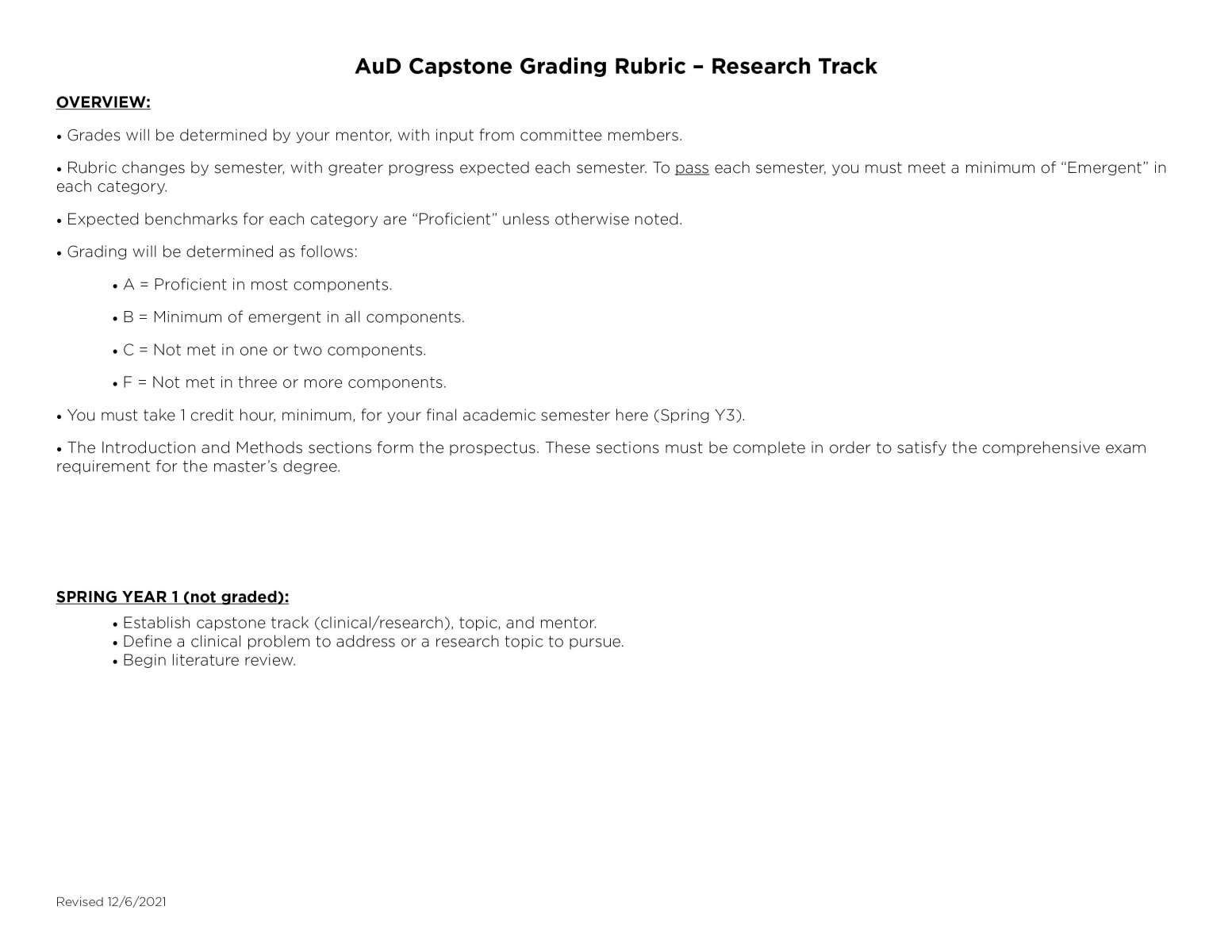
- Printer-friendly version
Au.D. Student Handbook
- Master's and Au.D. Degree Timelines
- Au.D. Curriculum and Advising
- Capstone Project
- Comprehensive Examination for the M.S.
- Comprehensive Examination for the Au.D.
- Academic Expectations
- Grievance and Appeals Procedures
- Academic Honesty & Integrity
- Professional Code of Ethics
- Student Resources
- Definition of an Audiologist
- Audiology Scope of Practice
- Professionalism in Audiology: Core Values
- Appendix 1: Au.D. Advising Form & Curriculum Guides
- Appendix 2: Sample Title Page for Au.D. Capstone Project
- Appendix 4: Au.D. Possible Electives & Ed Psych Courses
College of Computing

Navigating the Complexities of CS Capstone Programs: Insights from SIGCSE 2024
Wednesday, April 3, 2024
Emily Smith
College of computing school of computing instruction.
In many computer science (CS) programs, capstone projects are essential components for equipping students with practical skills and real-world experience. At the SIGCSE Technical Symposium last month, the School of Computing Instruction (SCI) delved into the challenges and strategies associated with running capstone programs.
In a birds of a feather session led by SCI Chair Olufisayo Omojokun and Research Associate KellyAnn Fitzpatrick, individuals from across the country joined to discuss their CS capstone programs. With live poll results from attendees helping to shape the conversation, the session offered insights to educators, students, administrators, and industry collaborators involved in CS capstone initiatives.

69% of respondents indicated that their institutions require capstone projects for CS majors.
Among those involved in Capstone programs at their institutions, many face similar challenges as their peers. Sourcing good projects remains a persistent hurdle, with educators striving to find projects that are both intellectually stimulating and aligned with industry needs.
Managing project difficulty poses another challenge, as instructors work to provide students with a challenging experience while ensuring projects are feasible within the constraints of the course.
Additionally, recruitment efforts to secure industry mentors can be time-consuming and require building strong relationships with professionals in the field.
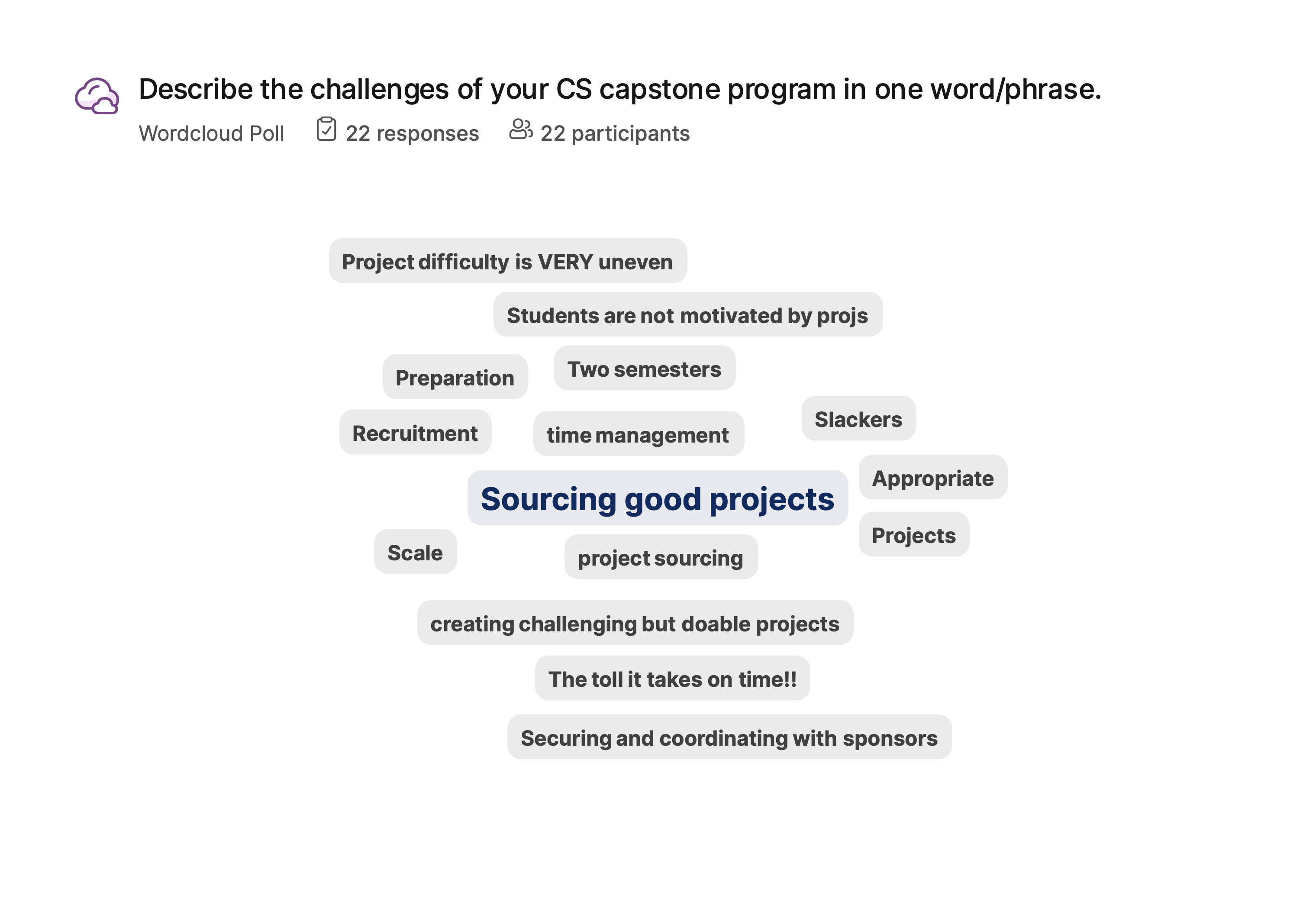
Program Scale and Duration
Respondents provided insights into their courses’ scale and duration, with variations in the number of capstone teams per semester and how long the courses last.
Most respondents host less than 20 capstone teams per semester while about a quarter—like Georgia Tech--host more than 50, highlighting the importance of scaling programs.
Moreover, a considerable percentage of programs span two semesters. This extended timeframe allows students to delve deeper into project development, especially with large projects, attendees said. The multi-semester format also offers students a more comprehensive and immersive experience, giving them time to collaborate and produce high-quality projects.

Project Sourcing and Quality
Survey responses also shed light on the multifaceted process of project sourcing and the importance of ensuring project quality.
While faculty and industry clients are primary sources of projects, student-initiated proposals also play a significant role. Additionally, many leverage their network of community partners, local tech start-ups, and non-profit organizations for project opportunities, ensuring alignment with real-world needs and industry trends.
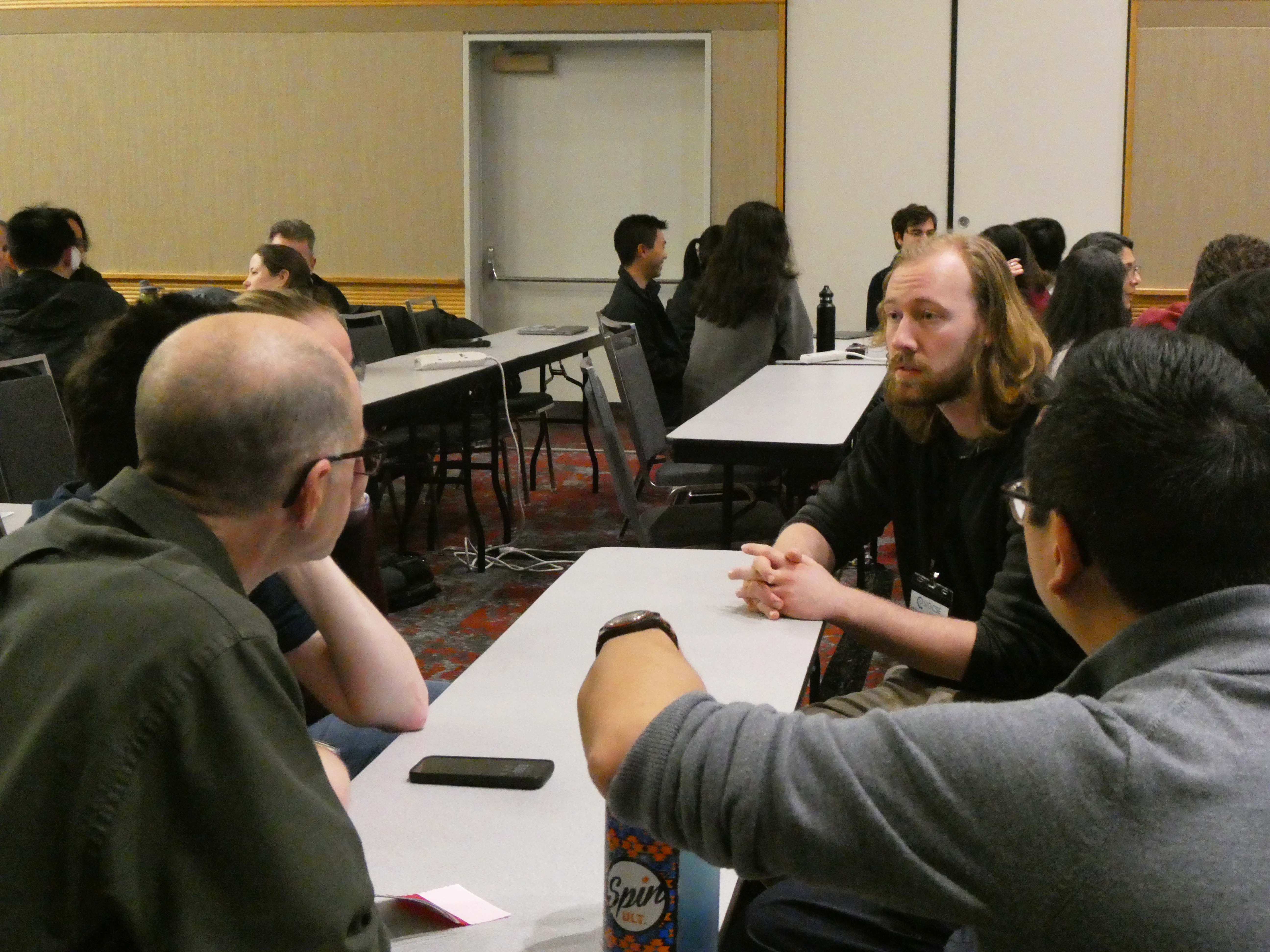
Attendees vet the quality of potential projects through project assessment rubrics, double-blind review processes, and input from industry experts. These efforts aim to create project standards and align projects with student skill levels.
However, most cite difficulties establishing a vetting process, especially one that scales.

Intellectual Property Handling :
In managing intellectual property (IP) for CS capstone projects, attendees employ a range of approaches to ensure clarity and fairness with teams. Some use formal agreements to clarify ownership among students, clients, and the university. But most respondents noted that IP agreements are project specific or established as needed.
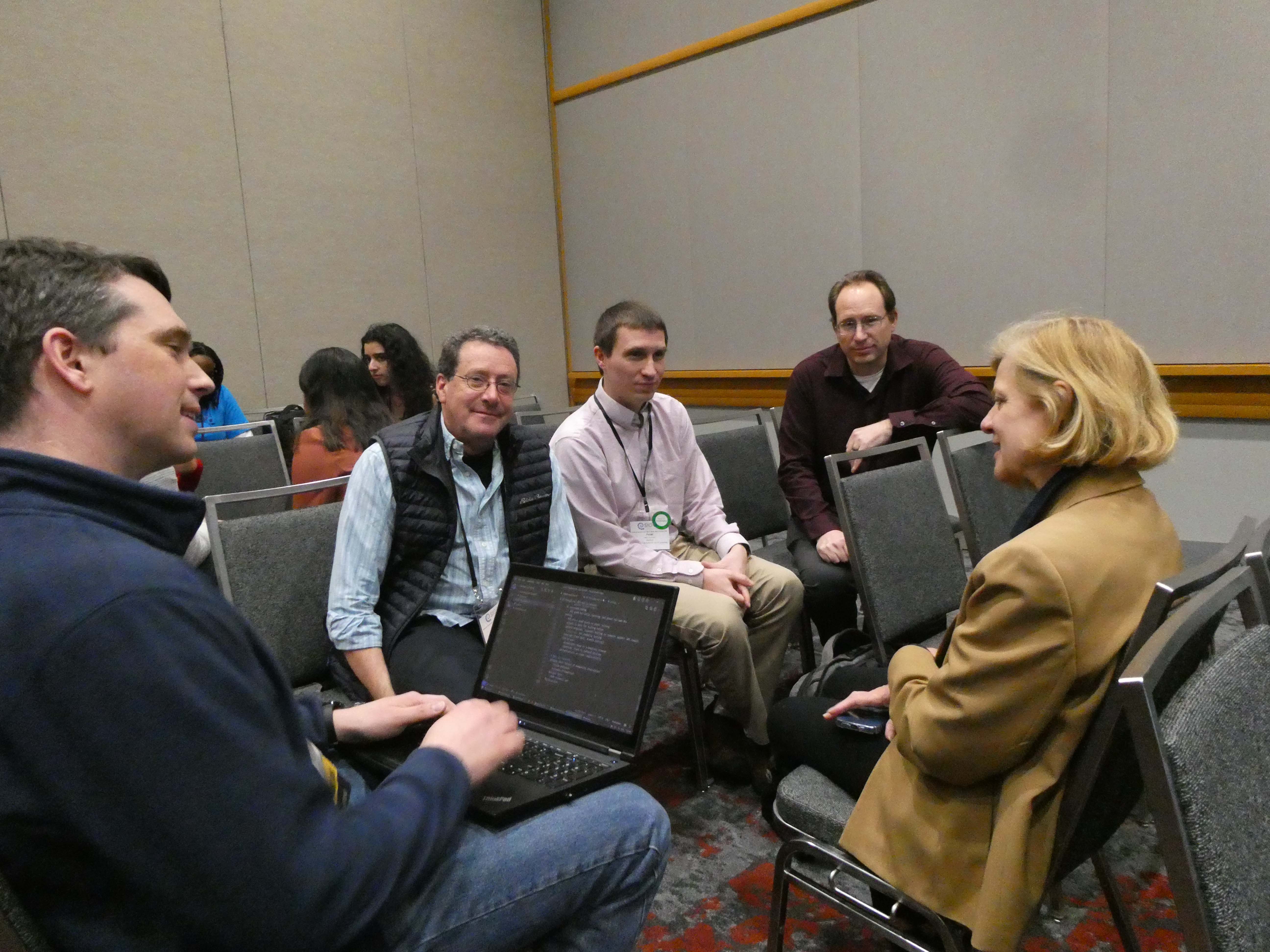
In some cases, the university retains IP rights, allowing potential commercialization. In other cases, students own their contributions.
Georgia Tech's policy leaves the IP rights up to the student to determine. Lecturers point them towards legal resources on campus to help them in their decision making.
Open communication was emphasized by one respondent to foster understanding and mitigate conflicts among stakeholders.
Knowledge Sharing and Collaboration :
Overall, attendees highlighted various challenges they hope to address in their courses, such as securing projects, managing time, motivating students, and navigating industry collaborations. Strategies for sourcing projects, managing large-scale initiatives, and enhancing student engagement were also discussed.
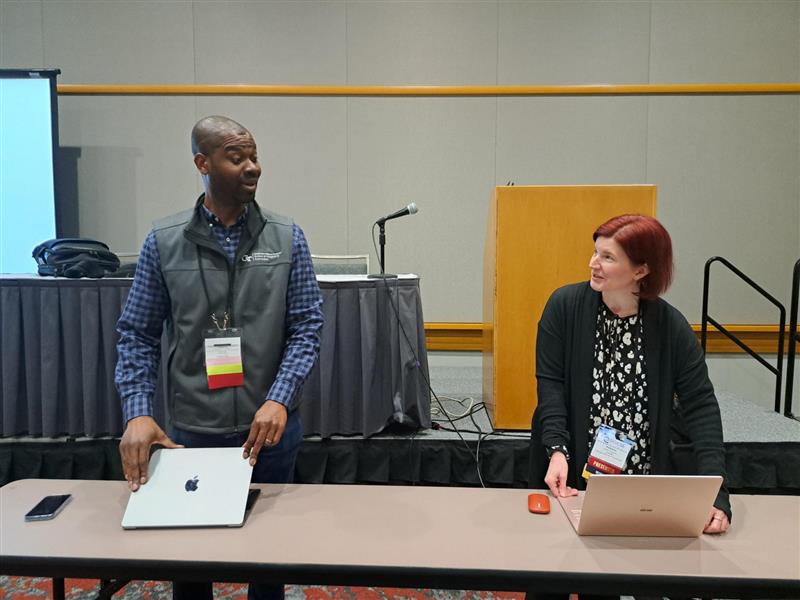
“One of our reasons for running this session was to begin to build lasting collaborative relationships among attendees involved with these courses so that we can better learn from each other,” said Fitzpatrick. “Based on the conversations among session attendees, we need more knowledge sharing and less knowledge silos when it comes to how different institutions manage their CS capstone projects.”
Future SIGCSE attendees can expect additional engaging discussions from SCI about CS Capstone programs.
Visit here for complete survey results.
Recent Stories

Two-World Training Approach Earns Roboticist NSF CAREER…
Thursday, April 4, 2024
Experts Say Life-long Learning is a Must to Keep Pace with…

DataWorks Says Farewell to Cohort Two
As we step into 2024 and reflect on the previous year, 2023 was a huge year for news stories here at @GTcomputing . Dive into the 184 published news stories of 2023 and see if theres anything you missed! https://t.co/zUHBPiiEwp — Georgia Tech Computing (@gtcomputing) January 11, 2024
@gtcomputing Students do more than just code! Sarah Jiang is pursuing her degree while continuing to follow her passion for art, collaborating with Nike and chart-topping artists. https://t.co/sFboZ5OSvT — Georgia Tech Computing (@gtcomputing) March 11, 2024
- The capstone blog
- Frequently asked questions
- Case studies
- Guides and tools
- Useful links
- News archive
- The capstone survey
- Case study collection
Samples: Rubrics
Posted Jun 23 2014 by Admin
Rubrics are useful marking guides for dimensions of assessment deliverables, behaviours and activities. We are collecting and adapting rubrics as we review capstones across the disciplines and identify dimensions. These are linked as documents below:
The Value Rubrics from the Association of American Colleges and Universities – 16 rubrics covering a range of capabilities at what they refer to as ‘benchmark, milestone and capstone level’ (the latter being the highest performance level rather than a capstone outcome):
Intellectual and Practical Skills
- Inquiry and analysis
- Critical thinking
- Creative thinking
- Written communication
- Oral communication
- Quantitative literacy
- Information literacy
- Problem solving
Personal and Social Responsibility
- Civic engagement—local and global
- Intercultural knowledge and competence
- Ethical reasoning
- Foundations and skills for lifelong learning
- Global learning
Integrative and Applied Learning
- Integrative learning
Rubric for the six facets of understanding – beautifully written and conceptually thorough rubric outlining levels of achievement in Explanation, Interpretation, Application, Perspective, Empathy and Self-Knowledge. Wiggins, G. P., & McTighe, J. (2005). Understanding by design . Ascd. pp.76-77 The rubric has been adapted across the world, and can also be downloaded from http://faculty.fullerton.edu/npelaez/BIOL102/UBDrubric.htm
Unless otherwise noted, content on this site is licensed under the Creative Commons Attribution- ShareAlike 3.0 Unported License Information on the creative commons licence can be found at: http://creativecommons.org.au/licences

info(at)capstonecurriculum.com.au

IMAGES
VIDEO
COMMENTS
Evaluation of Capstone Using this Rubric: The Primary Advisor is responsible for reading and evaluating the student's final Capstone paper using this rubric. The Primary Advisor will also make a recommendation for a final course grade. If the Committee Chair is NOT the student's Primary Advisor, the Chair will also evaluate the Capstone ...
As part of the Process for Evaluation for the class of 2020 capstone project, all districts and schools must evaluate student capstone projects utilizing a common rubric for all projects that will be used to satisfy graduation requirements. Districts and schools may utilize this sample rubric or a locally designed rubric that evaluates all ...
The capstone project rubric is a comprehensive evaluation tool for assessing your capstone project's quality. It clearly explains the criteria for evaluating your work and is essential for ensuring a fair and objective assessment. The capstone project rubric is divided into several components, each evaluated based on specific criteria.
CAPSTONE PROJECT OUTLINE & RUBRIC Does Not Meet Expectations Meets Expectations 22. Critically assessed the literature (strengths and weaknesses). 23. Discussed how their study will address research questions left unanswered and provide new information. 24. Included citations - APA. Purpose of study 25. Stated the purpose of the study. 26.
This rubric was designed for essays and research papers in history (Carnegie Mellon). Projects. Example 1: Capstone Project in Design This rubric describes the components and standards of performance from the research phase to the final presentation for a senior capstone project in design (Carnegie Mellon).
Based on Alan Chong et al research work [10], rubrics framed for capstone project evaluation and its description with respect to COs are listed in the Table 7. The marks are allocated according the rubrics by the project review panel members.The sample result of final COs attainment for project work for one batch is presented in the Table 8. As ...
mechanical engineering capstone design sequence at the University of Rhode Island during 2007-2009. Rethinking of the approach and pedagogy in capstone design also provided an opportunity for us to develop new assessment instruments and rubrics for evaluation of the design projects. A list of assessment instruments that
This rubric was designed for essays and research papers in history, CMU. Projects. Example 1: Capstone Project in Design This rubric describes the components and standard of performance from the research phase to the final presentation for a senior capstone project in the School of Design, CMU.
faculty developed a rubric for assessing capstone projects. The objective of thi s paper is to present this rubric, the data collected over two years, and an analysis of the re sults. A blank rubric, shown in Table 1, is a one-page paper form that is completed by the instruc tor at the end of the semester.
Capstone Report Rubric - Completed by:_____ Date:_____ ... ☐ Project limitations are adequately identified and described ☐ Adequate discussion of short-term impact on community setting/practice/end-users in public health ☐ Adequate discussion of potential long-term .
The resulting rubric, through developing the report assessment criteria, is a rubric that assesses students based on the six categories listed in Table 4. Table 4 shows a mapping between the assessment criteria we used to assess our students for their capstone project report and the topics set out by CDIO syllabus version 2.0. A key
Writing is clear and appropriately sophisticated, with virtually no errors, and supports meaning. Writing is at or near professional level, has no errors, and enhances meaning. Adapted From: Brown M.E. (2012). Rubric for Assessment of the Special Project Capstone Project at Southern Connecticut State University.
The nature of Capstone A for DAG includes the proposal and the first chapters of project. Then, upon completion of this course, they have to develop their project and implement it at the same time. This is the Capstone B. They all have to comply all of these activities within the span of five semesters. Table 2.
The paper identified the lack of factors backing innovative and entrepreneurial skills through a capstone activity [ 3 ]. The rubric presented added the following factors of evaluation in the existing model of University of Putra Malaysia: (1) Innovative proposal = 15%. (2) Project output/system demonstration = 25%. (3) Project dissertation = 30%.
1 US Letter
The capstone design project is an opportunity for you and your teammates to solve a practical engineering design problem using the engineering skills and knowledge that you have developed over the past three years.
This study attempted to develop fair, relevant, and content-valid assessment tools for capstone project courses. Toward this goal, new rating instruments based on the concept of rubrics were proposed.
Capstone Project Rubric - Chapter 4 Criterion Exemplary (5) Competent/ Accomplished (4) Developing (3) Emerging/Novice (2) Not Present (0) Introduction and conclusion Introduction and conclusion are very well written. Introduction sets the tone for the entire chapter. Conclusion summarizes the chapter and prepares the reader for the next chapter.
2016. Rubrics have been developed to assess the proposal, interim report, final report and proposal as related to the engineering capstone project, to better assess the performance of the students and provide feedback to the students. The presentation will outline how the rubrics were developed and highlight some the challenges that arose in ...
The "Research Capstone Project STEM Guidelines, Project Descriptions, and Project Rubrics," authored. by Berlyn L. Amano, is a comprehensive resource that prov ides guidance to the re searchers as ...
Appendix 3: Au.D. Capstone Project Rubrics Printer-friendly version ‹ Appendix 2: Sample Title Page for Au.D. Capstone Project up Appendix 4: Au.D. Possible Electives & Ed Psych Courses ›
New rating instruments based on the concept of rubrics were proposed to develop fair, relevant, and content-valid assessment tools for capstone project courses and faculty and students perceived the new instruments fairer than the previous ones. This study attempted to develop fair, relevant, and content-valid assessment tools for capstone project courses.
69% of respondents indicated that their institutions require capstone projects for CS majors. ... Attendees vet the quality of potential projects through project assessment rubrics, double-blind review processes, and input from industry experts. These efforts aim to create project standards and align projects with student skill levels.
See also: The Value Rubrics from the Association of American Colleges and Universities - 16 rubrics covering a range of capabilities at what they refer to as 'benchmark, milestone and capstone level' (the latter being the highest performance level rather than a capstone outcome):. Intellectual and Practical Skills. Inquiry and analysis; Critical thinking